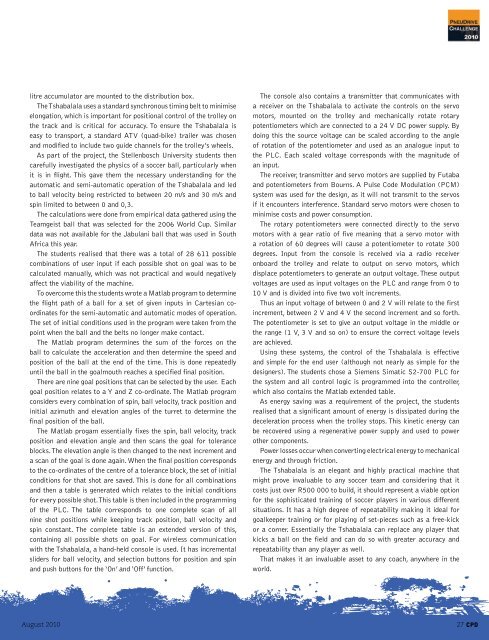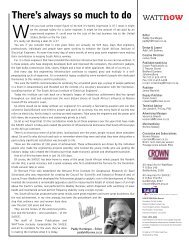download a PDF of the full August 2010 issue - Watt Now Magazine
download a PDF of the full August 2010 issue - Watt Now Magazine
download a PDF of the full August 2010 issue - Watt Now Magazine
- No tags were found...
Create successful ePaper yourself
Turn your PDF publications into a flip-book with our unique Google optimized e-Paper software.
litre accumulator are mounted to <strong>the</strong> distribution box.The Tshabalala uses a standard synchronous timing belt to minimiseelongation, which is important for positional control <strong>of</strong> <strong>the</strong> trolley on<strong>the</strong> track and is critical for accuracy. To ensure <strong>the</strong> Tshabalala iseasy to transport, a standard ATV (quad-bike) trailer was chosenand modified to include two guide channels for <strong>the</strong> trolley’s wheels.As part <strong>of</strong> <strong>the</strong> project, <strong>the</strong> Stellenbosch University students <strong>the</strong>ncare<strong>full</strong>y investigated <strong>the</strong> physics <strong>of</strong> a soccer ball, particularly whenit is in flight. This gave <strong>the</strong>m <strong>the</strong> necessary understanding for <strong>the</strong>automatic and semi-automatic operation <strong>of</strong> <strong>the</strong> Tshabalala and ledto ball velocity being restricted to between 20 m/s and 30 m/s andspin limited to between 0 and 0,3.The calculations were done from empirical data ga<strong>the</strong>red using <strong>the</strong>Teamgeist ball that was selected for <strong>the</strong> 2006 World Cup. Similardata was not available for <strong>the</strong> Jabulani ball that was used in SouthAfrica this year.The students realised that <strong>the</strong>re was a total <strong>of</strong> 28 611 possiblecombinations <strong>of</strong> user input if each possible shot on goal was to becalculated manually, which was not practical and would negativelyaffect <strong>the</strong> viability <strong>of</strong> <strong>the</strong> machine.To overcome this <strong>the</strong> students wrote a Matlab program to determine<strong>the</strong> flight path <strong>of</strong> a ball for a set <strong>of</strong> given inputs in Cartesian coordinatesfor <strong>the</strong> semi-automatic and automatic modes <strong>of</strong> operation.The set <strong>of</strong> initial conditions used in <strong>the</strong> program were taken from <strong>the</strong>point when <strong>the</strong> ball and <strong>the</strong> belts no longer make contact.The Matlab program determines <strong>the</strong> sum <strong>of</strong> <strong>the</strong> forces on <strong>the</strong>ball to calculate <strong>the</strong> acceleration and <strong>the</strong>n determine <strong>the</strong> speed andposition <strong>of</strong> <strong>the</strong> ball at <strong>the</strong> end <strong>of</strong> <strong>the</strong> time. This is done repeatedlyuntil <strong>the</strong> ball in <strong>the</strong> goalmouth reaches a specified final position.There are nine goal positions that can be selected by <strong>the</strong> user. Eachgoal position relates to a Y and Z co-ordinate. The Matlab programconsiders every combination <strong>of</strong> spin, ball velocity, track position andinitial azimuth and elevation angles <strong>of</strong> <strong>the</strong> turret to determine <strong>the</strong>final position <strong>of</strong> <strong>the</strong> ball.The Matlab progam essentially fixes <strong>the</strong> spin, ball velocity, trackposition and elevation angle and <strong>the</strong>n scans <strong>the</strong> goal for toleranceblocks. The elevation angle is <strong>the</strong>n changed to <strong>the</strong> next increment anda scan <strong>of</strong> <strong>the</strong> goal is done again. When <strong>the</strong> final position correspondsto <strong>the</strong> co-ordinates <strong>of</strong> <strong>the</strong> centre <strong>of</strong> a tolerance block, <strong>the</strong> set <strong>of</strong> initialconditions for that shot are saved. This is done for all combinationsand <strong>the</strong>n a table is generated which relates to <strong>the</strong> initial conditionsfor every possible shot. This table is <strong>the</strong>n included in <strong>the</strong> programming<strong>of</strong> <strong>the</strong> PLC. The table corresponds to one complete scan <strong>of</strong> allnine shot positions while keeping track position, ball velocity andspin constant. The complete table is an extended version <strong>of</strong> this,containing all possible shots on goal. For wireless communicationwith <strong>the</strong> Tshabalala, a hand-held console is used. It has incrementalsliders for ball velocity, and selection buttons for position and spinand push buttons for <strong>the</strong> ‘On’ and ‘Off’ function.The console also contains a transmitter that communicates witha receiver on <strong>the</strong> Tshabalala to activate <strong>the</strong> controls on <strong>the</strong> servomotors, mounted on <strong>the</strong> trolley and mechanically rotate rotarypotentiometers which are connected to a 24 V DC power supply. Bydoing this <strong>the</strong> source voltage can be scaled according to <strong>the</strong> angle<strong>of</strong> rotation <strong>of</strong> <strong>the</strong> potentiometer and used as an analogue input to<strong>the</strong> PLC. Each scaled voltage corresponds with <strong>the</strong> magnitude <strong>of</strong>an input.The receiver, transmitter and servo motors are supplied by Futabaand potentiometers from Bourns. A Pulse Code Modulation (PCM)system was used for <strong>the</strong> design, as it will not transmit to <strong>the</strong> servosif it encounters interference. Standard servo motors were chosen tominimise costs and power consumption.The rotary potentiometers were connected directly to <strong>the</strong> servomotors with a gear ratio <strong>of</strong> five meaning that a servo motor witha rotation <strong>of</strong> 60 degrees will cause a potentiometer to rotate 300degrees. Input from <strong>the</strong> console is received via a radio receiveronboard <strong>the</strong> trolley and relate to output on servo motors, whichdisplace potentiometers to generate an output voltage. These outputvoltages are used as input voltages on <strong>the</strong> PLC and range from 0 to10 V and is divided into five two volt increments.Thus an input voltage <strong>of</strong> between 0 and 2 V will relate to <strong>the</strong> firstincrement, between 2 V and 4 V <strong>the</strong> second increment and so forth.The potentiometer is set to give an output voltage in <strong>the</strong> middle or<strong>the</strong> range (1 V, 3 V and so on) to ensure <strong>the</strong> correct voltage levelsare achieved.Using <strong>the</strong>se systems, <strong>the</strong> control <strong>of</strong> <strong>the</strong> Tshabalala is effectiveand simple for <strong>the</strong> end user (although not nearly as simple for <strong>the</strong>designers). The students chose a Siemens Simatic S2-700 PLC for<strong>the</strong> system and all control logic is programmed into <strong>the</strong> controller,which also contains <strong>the</strong> Matlab extended table.As energy saving was a requirement <strong>of</strong> <strong>the</strong> project, <strong>the</strong> studentsrealised that a significant amount <strong>of</strong> energy is dissipated during <strong>the</strong>deceleration process when <strong>the</strong> trolley stops. This kinetic energy canbe recovered using a regenerative power supply and used to powero<strong>the</strong>r components.Power losses occur when converting electrical energy to mechanicalenergy and through friction.The Tshabalala is an elegant and highly practical machine thatmight prove invaluable to any soccer team and considering that itcosts just over R500 000 to build, it should represent a viable optionfor <strong>the</strong> sophisticated training <strong>of</strong> soccer players in various differentsituations. It has a high degree <strong>of</strong> repeatability making it ideal forgoalkeeper training or for playing <strong>of</strong> set-pieces such as a free-kickor a corner. Essentially <strong>the</strong> Tshabalala can replace any player thatkicks a ball on <strong>the</strong> field and can do so with greater accuracy andrepeatability than any player as well.That makes it an invaluable asset to any coach, anywhere in <strong>the</strong>world.<strong>August</strong> <strong>2010</strong> 27
















